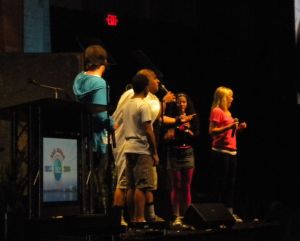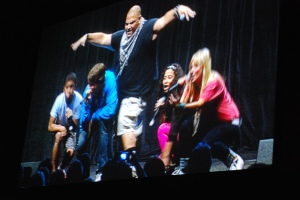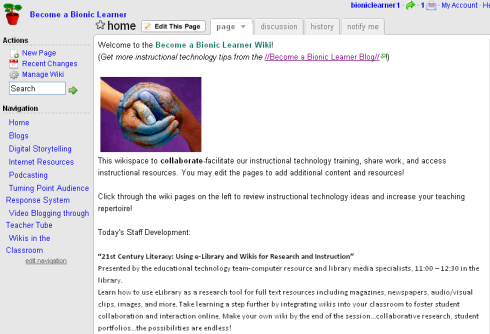Bloom’s Taxonomy Blooms Digitally, Andrew Churches
Posted using ShareThis

lessons learned from an instructional technologist

A few weeks ago I worked with our fashion marketing teacher on creating a Look Book to include all of her advanced fashion and introduction to fashion students. She had the idea of a Look Book where students would each have their own page where they included pictures of themselves and personal fashion information (including descriptions of their fashion style, professional aspirations, interests, etc.). She originally wanted to have students make pages out of MS Publisher, Word, or event PowerPoint and to print them so she could compile and bind them in a book. However, I suggested she try Mixbooks-a free online scrapbooking site. I knew it was starting to be a widely used resource for students, but I had never implemented it in the classroom before. I had only heard a few success stories where teachers had students create their own individual mixbook, but I hadn’t heard of anyone making a collaborative book with multiple students working on one mixbook.
I started playing with Mixbook myself and created a mixbook of my family’s Easter pictures. It was very easy to use. To create a fantastic book, all you needed to do was:
1. upload pictures
2. choose layouts for the pages (there are TONS of layouts that include multiple pictures…even goes up to 20 pictures on page!)
3. choose a theme and/or backgrounds for your mixbook/pages (again..there are TONS of options)
4. add stickers (each theme/background comes with a variety of stickers. you don’t need to stick to a theme…yet again…TONS to choose from!

Okay…it was easy enough. Now what about the collaboration part? I went to Twitter and posted an all-call on how I could have students collaborate on one single Mixbook. Thankfully, @cclancy responded that it was possible and a link to his blog “Chris’ 21st Century Learning Blog and his post: Create Amazing Digital Books with Mixbook. He gives an awesome overview of what Mixbook is, step by step how he has implemented it in the classroom, and also points to consider. He also has a great example of a classroom Mixbook created by a 5th grade class for social studies.
I pretty much followed his formula with the exception of changing the settings on the mixbook we were creating to be set to private and viewable only by those invited (since we were including student photographs). Here are some lessons learned from this experience:
1. Create a free account using mailcatch.com. I didn’t want to use the teacher’s school email or personal email to create the Mixbook account. Mailcatch.com site allows you to create an “inbox” but you can’t send any outgoing email. You don’t even need to register or complete any form. Just create a mixbook account with a made up mailcatch.com email (i.e. mixbook@mailcatch.com) and voila…you are in business.
2. Assign each student a page and direct them to the page and the individual view page mode when you assign it to them.
3. Instruct students to work from left to right with all the page options. This helped avoid layering confusion for some reason.
4. For text boxes, students may have to go to full screen mode and then back to regular screen for their text to be visible. Sometimes students had to do this to “kick the textboxes in the teeth”.
5. Have students upload 1 picture and one student at a time. When I let multiple students upload at will, it caused some network traffic and uploading froze.
6. Instruct students to not jump off of their page and view other pages as they were working. This caused students to lose work they saved for some reason.
7. Have students save one at a time. Students had to raise their hand when they were ready to save. I had them save and immediately log out. Onced saved, I had students log out and log back in to check that everything saved correctly.
When I followed the above protocols, we didn’t have any issues with student work. I’ve invited other teachers in other disciplines to take a look at the mixbook we created. I’m hoping other teachers will be interested. The possibilities are endless!
This is a copy of a posting from Dr. Maria Droujkova from the Twittermoms Ning:
This Wednesday night, July 8th, 5pm Pacific/8pm Eastern, there will be an online event consisting of a brief interview with me (Dr. Maria Droujkova), an active exchange of ideas, brainstorming, and making collaboration plans. The topic is “Math 2.0” – that is, mathematics as it relates to social media and new web technologies. Mark your calendars.
Not only is mathematics currently lagging in social spaces, the lag is increasing with time. Kids from the “digital native” generation are native to spaces where specialists still broadcast math from ivory towers, and kids aren’t welcome to contribute content. Most pedagogically innovative math computer games are at least fifteen years old. Come discuss these and other trends, mostly alarming but occasionally hopeful, and meet interesting people ready to take action together.
Steve Hargadon, the founder of Classroom 2.0, Future of Education and LearnCentral will lead the interview. It will take place in an Elluminate webinar room you can access at http://tinyurl.com/futureofed If you have never used Elluminate before, come earlier to download the client and set it up. It will be open half an hour ahead of time. More detailed information about the event will be uploaded to the Future of Education sitehttp://www.futureofeducation.com by Tuesday, July 7th.
If you still can’t seem to grasp what Twitter is, here is a great video. I didn’t quite understand the power of my personal learning network until recently. Installing Tweetdeck has made my use of Twitter more powerful because it has allowed me to search for individuals with like interests. Be to ing able to search for “tweets” or Twitter postings by hash tags (for example, when I went to NECC 2009, I was able to keep up with everyone’s Twitter postings related to NECC by searching for #NECC09 on Tweetdeck). Likewise, you can ensure that other people in and outside of your network may come across your posting if you know the hashtag for it. More on Twitter later…

Sunday’s Opening Keynote session was introduced by ISTE President Helen Padgett who emphasized that students need to walk into school and feel like they are taking a “step towards the future, and not a step back in time”. This sentiment rang true in the constant challenge we have as instructional technologists to bridge the distance between digital immigrants and digital natives. Padgett mentioned notable strides and achievements including that at McKinley Technology High School in Washington, D.C. The school is a prime example of the success of community partnerships. Ninety-eight percent of its students have been accepted into colleges (including ivy league schools) including Stanford, Cornell, and Duke.

Another notable point is that the National Educational Computing Conference will no longer we called NECC. It will officially be called the ISTE Conference beginning with next summer’s conference (ISTE 2010) in Denver, Colorado June 27th-30th.

Malcolm Gladwell, author of The Tipping Point, Blink, and Outliers: The Stories of Success was the Opening Keynote speaker for the conference. His keynote focused on the question of “meaningful learning environments” a nd what it takes to create them. He proposed 3 preconditions for it to happen and related them to, of all subjects, Fleetwood Mac! Here are a few notes from his keynote address:
Effort is essential for meaningful learning…
The success of Fleetwood Mac has taken 20 years and 26 albums.
“We telescope how long that learning takes place”…”underestimate how much time, energy, and struggle” is behind a successful organization, classroom, individual
There is a 10 year rule for success and proficiency proposed by psychologists…10,000 hours of practice necessary…which comes to 4 hours a day for all successful individuals
Effort…successful learning doesn’t begin with a talent, but with an approach to the task
Example: American students-will say you have to have a “talent” for math to be good for it. Asian counterparts-to do well at math takes effort.
Perseverance is essential…you must “build on your failures”…
We tend to embrace the capitalization learning style: where people build on their strengths until you reach an optimal state
But this is not the only kind of strategy. We need to try the compensation strategy. Instead of building on your strengths, you compensate on your weaknesses. When you find success from the compensation strategy, the results are much more meaningful and weighted.
Example: In NFL Football, the top 50 draft pics underperform compared to the 51+ draft picks.
“We need to have respect for difficulty.”
So the big question is…”How do we set up an environment where students are enabled to “flex” their compensation muscles?
Feedback is a critical aid to effective learning…
We incorrectly think our learning/experience has to be linear. “We value and treasure the role of timely and targeted feedback as an aid to effective learning”
Feedback lies at the core of effective learning. We must take time to not only solicit feedback, but evaluate the results to see how we can improve.
Summarizing point:
“Sometimes the struggle in learning something is where the learning lies.”
I thought his address was an interesting way to start the conference. It did help me think about how I can help teachers adjust their paradigms to broaden their scope of the opportunities and potential they have their classrooms with technology. Providing professional development for my teachers to improve classroom instruction is a challenge. Some thoughts on professional development I have to parallel Gladwell’s address:
1. Effort-
Develop a professional development plan and stick with implementation for several years. Results may not be apparent until later.
Increasing teacher effort in attending professional development-Work with administration on paid time, substitutes, professionl recertification points, etc. Work with community partners to provide snacks, freebies, assistance, etc., Align training with teacher planning periods, inservice days; Align training to support school’s improvement plan and critical curricululm and instructional needs
2. Perseverence
How do you keep teachers from quitting on implementing a technology tool if it “fails” the first time? I see this problem often. I never feel technology fails. Most of the time, any snags in implementing the technology tool was because of lack of planning and lack of understanding the tool.
I’m stuck here…please offer suggestions!
3. Feedback
Provide a “feedback/closure” session with teachers after a collaborative project; solicit feedback from students on what was learned and what could have been improved; develop improvement plans from feedback
Does anyone have any concrete suggestions on “how” to set up these preconditions in a school/classroom to create an effective and meaningful learning environment for teachers (professional development) and students? I’d love to hear your responses!
At the National Educational Computing Conference (NECC) 2009, I attended Leslie Fisher’s gadgets session. Leslie Fisher is the Director of Fisher Technologies Incorporated which focuses on web development for the k-12 education sector. In the session she went over gadgets and websites to help you with your personal life and endeavors. She’s a great speaker and I highly recommend you catching her at a conference! Here are my notes from the session:
Websites to help keep you organized or make life easier:
Tripit.com-send travel itineraries from your email account
Yelp.com-online reviews of business all over the country
Jott.com-gives an 800 number that you dial that you can send to email to create a to do list.
Works well with rememberthemilk.com-another free site that allows you to create/edit your To Do List from anywhere
Evernote-web-based application that creates ocr text recognition
Ustream.tv-free account allows you to broadcast a live video feed to anyone
Mozy.com-online backup for mac and pc
iStockphoto.com-anyone can submit a picture, but staff of site will evaluate if it is worthy of putting online…once it is posted, it is royalty free.
Edutecher.net-tons of web 2.0 apps for education
Http://betaserendipity.com make your own flash games
Smugmug.com-upload not limited like in flickr, allows you to sell photos, watermarks, order on t-shirt, etc. can use for sporting events. Search for nonprofit and can have a FREE professional level account
Cool Gadgets:
Sling Media-external box that hooks up to your home theater no matter how big or small, then uses a internet connection to broadcast the signal to CPU, phone, etc.
Netflix roku-$99) no monthly fee if you are a netflix member with 2 + DVDs a month, allows you to instantly watch 10,000+ movies on demand
Logitech-Harmony One-all in one remote for up to 15 devices ($249-499.00)
http://ion-audio.com ($134.00) Record player w/usb that allows you to create an MP3 out of your old record!
I got to see the cast of the new Electric Company by PBS! My kids actually love this show. I recorded it just so I could explain to them how I used to love the original show. I never thought they would fall in love with it. It’s actually one of the few shows I actually feel absolutely fine with them watching. The kids did a wonderful job with the pre-show. I actually found myself groovin’ to their funkdafied performances =)


If your kids haven’t seen the new Electric Company, I highly suggest you check your local PBS station and see when it shows. If you loved the original series from the 70s, there are some similarities with styling, music, and literacy lessons, but it is practically a different show. However, it’s very educational and worth a watch!
I promised you all that I would chronicle my “newbie” experience at the National Educational Computing Conference (NECC) 2009 in Washington D.C., so here goes. Unfortunately, I wasn’t able to leave a day early for NECC to participate in the EduBloggerCon festivities. So what did I do? I listened in through UStream. The Web 2.0 Smackdown was delivered through Ustream and CoverItLive, which was a great combination to get the information virtually. All events were covered by Elluminate, which proved to have almost impossible to hear audio. You can access recorded video of the events at the EduBloggerCon “Live in DC” 2009 wiki page.
The Web 2.0. Smackdown provided an open forum for attendees to belly up to the mic and have 3 minutes to share a web 2.0 application. Some of the offerings that I found interesting included the following:
Images
Tinyeye.com-reverse image search engine
Taggalaxy.de-flickr tag search
Google-“similar images link” is now there..!!!!
Comfight.com-search flickr with creative commons off and on
Toogle-http://c6.org/toogle/-image search engine that returns photos made of the word searched for
Music
Noteflight.com (2-5) like Sibelius
Jamstudio.com-can be used with Audacity
Chat/video streaming
Todaysmeet.com-find a virtual meeting spot free and easy
Ustream.tv-broadcast your own content!
CoverItLive.com-perfect for blogging a live event, presents blog in a live window where you can see real-time comments!
Professional connections/networks
Edtechtalk.com-community of webcasting
Games
Freshbrain.org-make 3d video games
iPhone apps
Bumptechnologies.com-allows you to swap info between iphones
Video search
Here is a listing of educational grant opportunities from Tech&Learning.
I’ve linked the Become a Bionic Learner Wiki to the blog site. I use it for posting information on my staff development sessions. Feel free to use it as a your own personal learning tutorial of instructional technology ideas.
